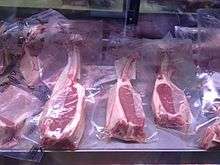Skin pack
Skin pack, or skin packaging, is a type of carded packaging where a product (or products) is placed on a piece of paperboard or in trays, and a thin sheet of transparent plastic is placed over the product and paperboard or trays.[1][2] [3] The printed paperboard/tray usually has a heat-seal coating. The plastic film (LDPE, PVC, ionomer, etc.) is softened by heat and draped over the product on the card/tray. Vacuum is sometimes used to assist a firm fit. The film bonds to the heat-seal coating on the paperboard. The skin-packed piece then may need to be cut into individual units.
Self-adhesive film with uncoated card is also sometimes used.
Skin packaging somewhat resembles a blister pack, with the major difference being that the plastic surrounding the product is formed over the product, instead of being pre-formed.
Types of plastic film:
- Polyethylene
- PVC
- Ionomer
- PET
Meat

Fresh meat can be vacuum packed and skin packed. Specialized packaging operations are needed to maintain product appearance and safety. Temperature control during the cold chain is needed for proper shelf life.[4]
References
- US3966045A, Perdue, "Skin package", published 1976
- US3491504A, Young, "Method and apparatus for vacuum skin packaging", published 1970
- {{cite patent - | number =US3830365A | title =Vacuum skin packaging and packages | pubdate =1966 | inventor =Holt | url =https://patents.google.com/patent/US3830365A/en }}
- Carpenter, C E (2001). "Consumer preferences for beef color and packaging did not affect eating satisfaction" (PDF). Meat Science. 57: 359–363. doi:10.1016/s0309-1740(00)00111-x. Retrieved 14 October 2018.
- Yam, K.L., "Encyclopedia of Packaging Technology", John Wiley & Sons, 2009, ISBN 978-0-470-08704-6
- Soroka, W, "Fundamentals of Packaging Technology", IoPP, 2002, ISBN 1-930268-25-4